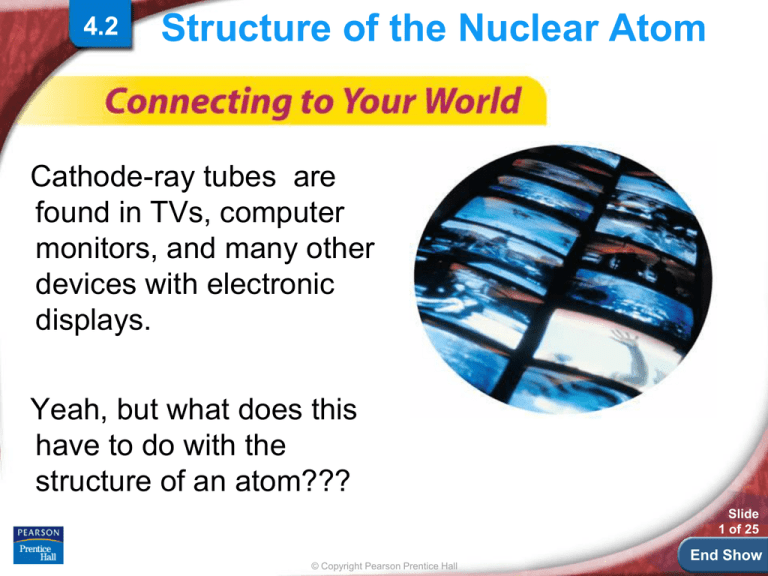
4.2
Structure of the Nuclear Atom
Cathode-ray tubes are
found in TVs, computer
monitors, and many other
devices with electronic
displays.
Yeah, but what does this
have to do with the
structure of an atom???
Slide
1 of 25
© Copyright Pearson Prentice Hall
End Show
4.2
Structure of the Nuclear Atom
>
Subatomic Particles
Three kinds of subatomic particles are
electrons, protons, and neutrons.
Electrons
•
In 1897, the English physicist J. J. Thomson
(1856–1940) discovered the electron.
Electrons are negatively charged subatomic
particles.
Slide
2 of 25
© Copyright Pearson Prentice Hall
End Show
4.2
Subatomic Particles
Cathode Ray Tube
Thomson performed experiments that involved passing
electric current through gases at low pressure using a
cathode-ray tube. The result was a glowing beam, or
cathode ray, that traveled from the cathode to the anode.
4.2
Structure of the Nuclear Atom
>
Subatomic Particles
A cathode ray is deflected by electrically
charged plates. Thomson concluded that a
cathode ray is a stream of electrons. Electrons
are parts of the atoms of all elements.
Slide
4 of 25
© Copyright Pearson Prentice Hall
End Show
4.2
Structure of the Nuclear Atom
>
Subatomic Particles
A cathode ray is also deflected by a magnet.
Slide
5 of 25
© Copyright Pearson Prentice Hall
End Show
4.2
Structure of the Nuclear Atom
>
Subatomic Particles
Protons and Neutrons
In 1886, Eugen Goldstein (1850–1930) observed
a cathode-ray tube and found rays traveling in
the direction opposite to that of the cathode rays.
He concluded that they were composed of
positive particles.
Such positively charged subatomic particles are
called protons.
Slide
6 of 25
© Copyright Pearson Prentice Hall
End Show
4.2
Structure of the Nuclear Atom
>
Subatomic Particles
In 1932, the English physicist James Chadwick
(1891–1974) confirmed the existence of yet
another subatomic particle: the neutron.
Neutrons are subatomic particles with no
charge but with a mass nearly equal to that of a
proton.
Slide
7 of 25
© Copyright Pearson Prentice Hall
End Show
4.2
Structure of the Nuclear Atom
>
Subatomic Particles
Table 4.1 summarizes the properties of
electrons, protons, and neutrons.
Slide
8 of 25
© Copyright Pearson Prentice Hall
End Show
4.2
Structure of the Nuclear Atom
>
The Atomic Nucleus
The Atomic Nucleus
How can you describe the structure of
the nuclear atom?
Slide
9 of 25
© Copyright Pearson Prentice Hall
End Show
4.2
Structure of the Nuclear Atom
>
The Atomic Nucleus
J.J. Thompson and others supposed the atom
was filled with positively charged material and
the electrons were evenly distributed throughout.
This model of the atom turned out to be shortlived, however, due to the work of Ernest
Rutherford (1871–1937).
In 1911, Rutherford and his coworkers at the
University of Manchester, England, directed a
narrow beam of alpha particles at a very thin
sheet of gold foil.
Slide
10 of 25
© Copyright Pearson Prentice Hall
End Show
4.2
Structure of the Nuclear Atom
>
The Atomic Nucleus
Rutherford’s Gold-Foil Experiment
Slide
11 of 25
© Copyright Pearson Prentice Hall
End Show
4.2
Structure of the Nuclear Atom
>
The Atomic Nucleus
Alpha particles scatter from the gold foil.
Slide
12 of 25
© Copyright Pearson Prentice Hall
End Show
4.2
Structure of the Nuclear Atom
>
The Atomic Nucleus
The Rutherford Atomic Model
Rutherford concluded that the atom is mostly
empty space. All the positive charge and almost
all of the mass are concentrated in a small region
called the nucleus.
The nucleus is the tiny central core of an atom
and is composed of protons and neutrons.
Slide
13 of 25
© Copyright Pearson Prentice Hall
End Show
4.2
Structure of the Nuclear Atom
>
The Atomic Nucleus
In the nuclear atom, the protons and
neutrons are located in the nucleus.
The electrons are distributed around
the nucleus and occupy almost all the
volume of the atom.
Slide
14 of 25
© Copyright Pearson Prentice Hall
End Show
4.2 Section Quiz
Assess students’ understanding
of the concepts in Section 4.2.
Continue to:
-or-
Launch:
Section Quiz
Slide
15 of 25
© Copyright Pearson Prentice Hall
End Show
4.2 Section Quiz
1. Which of the following is NOT an example of
a subatomic particle?
a. proton
b. molecule
c. electron
d. neutron
Slide
16 of 25
© Copyright Pearson Prentice Hall
End Show
4.2 Section Quiz
2. The nucleus of an atom consists of
a. electrons only.
b. protons only.
c. protons and neutrons.
d. electrons and neutrons.
Slide
17 of 25
© Copyright Pearson Prentice Hall
End Show
4.2 Section Quiz
3. Most of the volume of the atom is occupied
by the
a. electrons.
b. neutrons.
c. protons and neutrons.
d. protons.
Slide
18 of 25
© Copyright Pearson Prentice Hall
End Show


